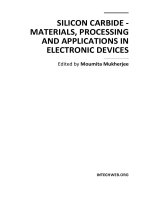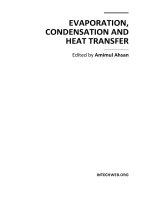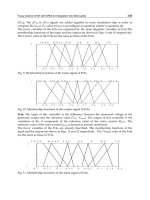Advanced Topics in Mass Transfer Part 1 doc
Bạn đang xem bản rút gọn của tài liệu. Xem và tải ngay bản đầy đủ của tài liệu tại đây (1.96 MB, 40 trang )
ADVANCED
TOPICS IN
MASS TRANSFER
Edited by Mohamed El-Amin
Advanced Topics in Mass Transfer
Edited by Mohamed El-Amin
Published by InTech
Janeza Trdine 9, 51000 Rijeka, Croatia
Copyright © 2011 InTech
All chapters are Open Access articles distributed under the Creative Commons
Non Commercial Share Alike Attribution 3.0 license, which permits to copy,
distribute, transmit, and adapt the work in any medium, so long as the original
work is properly cited. After this work has been published by InTech, authors
have the right to republish it, in whole or part, in any publication of which they
are the author, and to make other personal use of the work. Any republication,
referencing or personal use of the work must explicitly identify the original source.
Statements and opinions expressed in the chapters are these of the individual contributors
and not necessarily those of the editors or publisher. No responsibility is accepted
for the accuracy of information contained in the published articles. The publisher
assumes no responsibility for any damage or injury to persons or property arising out
of the use of any materials, instructions, methods or ideas contained in the book.
Publishing Process Manager Iva Lipovic
Technical Editor Teodora Smiljanic
Cover Designer Martina Sirotic
Image Copyright clarusvisus, 2010. Used under license from Shutterstock.com
First published February, 2011
Printed in India
A free online edition of this book is available at www.intechopen.com
Additional hard copies can be obtained from
Advanced Topics in Mass Transfer, Edited by Mohamed El-Amin
p. cm.
ISBN 978-953-307-333-0
free online editions of InTech
Books and Journals can be found at
www.intechopen.com
Part 1
Chapter 1
Chapter 2
Chapter 3
Chapter 4
Chapter 5
Part 2
Chapter 6
Chapter 7
Preface IX
Mass Transfer in Microchannels,
Turbulence, Waves and Plasma 1
Mass-Transfer Characteristics
of a Double-Y-Type Microchannel Device 3
Susumu NII
Turbulent Buoyant Jet of a Low-Density Gas Leaks
Into a High-Density Ambient: Hydrogen Leakage in Air 19
M.F. El-Amin and Shuyu Sun
Controlled Mixing and Transport in Comb-Like
and Random Jet Array Stirring Systems 43
S. Delbos, E. Chassaing, P. P. Grand, V. Weitbrecht and T. Bleninger
Application of Airborne Sound
Waves for Mass Transfer Enhancement 61
Sergey V. Komarov
Mass-transfer in the Dusty Plasma as a Strongly Coupled
Dissipative System: Simulations and Experiments 87
Xeniya Koss, Olga Vaulina, Oleg Petrov and Vladimir Fortov
Mass Transfer and Hydro-, Magnetohydro-
and Electro- Dynamics 111
Forced Convection Mass-Transfer
Enhancement in Mixing Systems 113
Rafał Rakoczy and Stanisław Masiuk
Unsteady Magnetohydrodynamic Convective Heat
and Mass Transfer Past an Infinite Vertical Plate
in a Porous Medium with Thermal Radiation,
Heat Generation/Absorption and Chemical Reaction 145
Stanford Shateyi and Sandile Motsa
Contents
Contents
VI
Mass Transfer, and Effects of Magnetic Fields
on the Mass Transfer in Close Binary System 163
Davood Manzoori
A Mass Transfer Study with Electrolytic Gas Production 175
Eudésio O. Vilar, Eliane B.Cavalcanti and Izabelle L.T. Albuquerque
Mass Transfer Equation
and Hydrodynamic Effects in Erosion-Corrosion 191
A. Yabuki
Hydrodynamics and Mass Transfer
in Heterogeneous Systems 211
Radmila Garić-Grulovic, Nevenka Bošković-Vragolović,
Željko Grbavčić and Rada Pjanović
Flow and Mass Transfer
inside Networks of Minichannels 229
Florian Huchet
Simulation of Hydrodynamics and Mass Transfer
in a Valve Tray Distillation Column Using
Computational Fluid Dynamics Approach 265
A. Jafari, S.M. Mousavi, H. Moteshaffi,
H. Roohian and H. Hamedi Sangari
Mass Transfer in Food 281
Modeling Moisture Movement in Rice 283
Bhagwati Prakash and Zhongli Pan
Mass Transfer Mechanisms during Dehydration of
Vegetable Food: Traditional and Innovative Approach 305
Derossi A., Severini C. and Cassi D.
Mass Transfer in Cheese 355
Jorge F. Vélez-Ruiz
Mass Transfer in Large-Scale Applications 371
Comprehensive Survey of Multi-Elements in Coastal Sea
and Stream Sediments in the Island Arc Region of Japan:
Mass Transfer from Terrestrial to Marine Environments 373
Atsuyuki Ohta and Noboru Imai
Mass Transfers and Sedimentary Budgets
in Geomorphologic Drainage Basin Studies 399
Achim A. Beylich
Chapter 8
Chapter 9
Chapter 10
Chapter 11
Chapter 12
Chapter 13
Part 3
Chapter 14
Chapter 15
Chapter 16
Part 4
Chapter 17
Chapter 18
Contents
VII
Combined Heat and Mass Transfer 423
Successive Linearisation Solution
of Free Convection Non-Darcy Flow
with Heat and Mass Transfer 425
Sandile Motsa and Stanford Shateyi
Explicit and Approximated Solutions for Heat
and Mass Transfer Problems with a Moving Interface 439
Domingo Alberto Tarzia
Boundary Control Problems for Oberbeck–Boussinesq
Model of Heat and Mass Transfer 485
Gennady Alekseev, Dmitry Tereshko and Vladislav Pukhnachev
Heat and Mass Transfer in Desiccant Wheels 513
Celestino Ruivo, José Costa and António Rui Figueiredo
Oscillatory Regimes
of Solutocapillary Marangoni Convection 535
Konstantin Kostarev, Andrew Zuev and Antonio Viviani
Aerodynamics of Ceramic Regular Packing
for Heat-Massexchenge Processes 557
Alexandr Pushnov
Topics in Heat and Mass Transfer in Porous Media:
Cross-Diffusion, Thermophoresis and Reactive Surfaces 577
Adrian Postelnicu
Mass and Heat Transfer During Thin-Film
Evaporation of Liquid Solutions 611
Janusz Dziak
Part 5
Chapter 19
Chapter 20
Chapter 21
Chapter 22
Chapter 23
Chapter 24
Chapter 25
Chapter 26
Pref ac e
This book introduces a number of selected advanced topics in mass transfer phenom-
enon and covers its theoretical, numerical, modeling and experimental aspects. The
26 chapters of this book are divided into fi ve parts. The fi rst is devoted to the study
of some problems of mass transfer in microchannels, turbulence, waves and plasma,
while the chapters regarding mass transfer with hydro-, magnetohydro- and electro-
dynamics are collected in the second part. The third part deals with mass transfer
in food, such as rice, cheese, fruits and vegetables, while the fourth focuses on mass
transfer in some large-scale applications such as geomorphologic studies. The last part
introduces several issues of combined heat and mass transfer phenomena. The book
is considered as a rich reference for researchers and engineers working in the fi eld of
mass transfer and related topics.
Chapter 1 focuses on mass transfer characteristics of a microchannel device of double-Y
type. The second chapter studies the problem of a low-density gas jet injected into a
high-density ambient with an example of hydrogen leakage in air, which is consid-
ered an important issue facing hydrogen-energy developing. Controlled mixing and
transport in comb-like and random jet array stirring systems are studied in the third
chapter. The goal of the fourth chapter is to give a deeper insight into the possibilities
and limitations of airborne sound waves as a tool to enhance the rates of gas-phase
mass transfer and its related phenomena. In Chapter 5 simulations and experiments
are performed to investigate mass-transfer in dusty plasma as a strongly coupled dis-
sipative system.
Chapter 6 studies forced convection mass transfer processes under various types of
augmentation technique, i.e. rotational and reciprocating mixers and rotating mag-
netic fi eld. The seventh chapter studies unsteady magnetohydrodynamic convective
heat and mass transfer past an infi nite vertical plate in a porous medium with thermal
radiation, heat generation/absorption and chemical reaction. Eff ects of magnetic fi eld
on mass transfer in close binary systems are investigated in Chapter 8, while Chapter 9
studies the eff ect of hydrodynamic condition over mass transfer gas-electrodes for two
cathodes geometries during the hydrogen production at chlor-alkali cell by diaphragm
process in laboratory scale. In Chapter 10 mass transfer equation and hydrodynamic
eff ects are used to predict the Erosion-Corrosion damage. Hydrodynamics and mass
transfer in heterogeneous systems are presented in the eleventh chapter. The objective
of the experimental work presented in the twel h chapter is using several methods
in order to characterize fl ow and mass transfer inside networks composed of cross-
ing minichannels. Chapter 13 provides a CFD simulation of hydrodynamics and mass
transfer in a valve tray distillation column.
X
Preface
The purpose of Chapter 14 is to illustrate empirical and theoretical approaches based
upon principles of mass and heat transfer pursued in modeling of drying processes in
rice. The fi eenth chapter provides the conventional and emerging theories on mass
transfer during traditional and innovative drying technologies of fruits and vegetables.
The mass transfer in cheese is introduced in Chapter 16.
Chapter 17 provides a comprehensive survey of multi-elements in coastal sea and
stream sediments in the island arc region of Japan and mass transfer from terrestrial
to marine environments. Mass transfer and sedimentary budgets in geomorphologic
drainage basin studies are covered in Chapter 18.
In the nineteenth chapter a numerical perturbation scheme was developed for solving
complex nonlinear boundary value problems arising in problems of heat and mass
transfer, while the goal of Chapter 20 is to give a survey of some explicit and approxi-
mated solutions for heat and mass transfer in free or moving interface. The boundary
control problems for Oberbeck–Boussinesq model of heat and mass transfer are dis-
cussed in the twenty-fi rst chapter. In Chapter 22 the results of a detailed numerical
model are used to determine the eff ectiveness parameters for the coupled heat and mass
transfer processes in desiccant wheels. Chapter 23 describes experiments revealed by
the self-oscillatory regimes of solutal convection in an aqueous solution of surfactant
with vertically stratifi ed concentration. Aerodynamics of ceramic regular packing for
heat and mass exchange processes are studied in the twenty-fourth chapter. Chapter 25
covers cross-diff usion, chemical reaction, thermophoresis and reactive surfaces in the
area of heat and mass transfer convective processes in fl uid-saturated porous media.
The last chapter of this book, Chapter 26, introduces mass and heat transfer during
thin-fi lm evaporation of liquid solutions applied in heat exchangers.
Mohamed Fathy El-Amin
Physical Sciences and Engineering Division
King Abdullah University of Science and Technology (KAUST)
Part 1
Mass Transfer in Microchannels,
Turbulence, Waves and Plasma
1
Mass-Transfer Characteristics of a
Double-Y-Type Microchannel Device
Susumu NII
Nagoya University
Japan
1. Introduction
Microfluidic devices have been extensively applied to high-throughput chemical analyses or
reactions using hazardous substances (van den Berg et al., 2000). These systems are
characterized by a large area per volume and a well-defined laminar flow. As a result of
their high potential for the precise manipulation of chemical reactions with respect to
controlled temperature, contacting time, and molecular orientation at the interface,
researches on microfluidic devices for the production of highly valuable substances are
increasing in importance (Ajmera et al., 2001, Maruyama et al., 2003, Löb et al., 2004). The
production system is often referred to as a desktop chemical plant and the keys to realizing
the plant are understanding and successfully manipulating the flow in microchannels
(Hetsroni et al., 2005).
A unique feature of the microchannels is the formation of liquid layers when multiple
liquids are brought into one channel. Reactions and/or mass-transfers occur in the vicinity
of the interface. Liquid-liquid extractions (Brody and Yager, 1997, Tokeshi et al., 2000) are
reported for systems of aqueous and organic solutions. Even mutually miscible liquids form
the layers because of the laminar-flow nature (Yamaguchi et al., 2004) and a mass-transfer
occurs between the liquids under well-controlled conditions. For the purpose of chemical
processing, the stacked liquid layers should be separated in each layer for further treatment.
However, flow splitting in microchannel devices is rarely found in published papers. In
reported works for the analytical application of microchannels, the solute’s concentration
profile was directly measured within the channel using a laser-based refractive index
detector (Costin and Synovec, 2002) or a microscope for measuring fluorescence emission
(Costin et al., 2004). A strategy for flow splitting has not yet been developed for the
application of microchannel devices to analytical chemistry.
In the present study, two aqueous layers were brought into contact and separated into two
streams after a mass-transfer between the layers. The amount of solute transferred was
obtained with a simple analysis of liquid samples taken at the channel outlet. The mass-
transfer characteristics were examined through the measurement of the diffusion
coefficients for solutes. Even under carefully controlled liquid feed conditions, equal flow
splitting was difficult to obtain. Proposed is a method to choose solute concentration data
for equal flow splitting using the ratio of the flow rate of one liquid to the other. The mass-
transfer of benzoic acid was successfully analyzed with a conventional penetration model
with an additional parameter. Furthermore, the diffusion coefficients of sucrose, glycine,
Advanced Topics in Mass Transfer
4
tryptophan, and urea were measured using a basic equation obtained with benzoic acid. The
values are in accordance with the literature or the correlated values. Since the same
parameter is applied for obtaining the diffusion coefficients of the four different solutes, the
additional parameter should characterize the flow behavior in the microchannel. The
proposed method is also useful for determining the unknown diffusivities of solutes.
Furthermore, to investigate the flow characteristics, the value of an additional parameter is
determined in various channels having different lengths, depths and knife-edge angles.
A Comparison of this parameter helps us to understand the effect of flow on mass-transfer.
2. Determination of diffusivity
2.1 Microchannel module and materials
Benzoic acid, sucrose, tryptophan, urea, and glycine were selected as transferring solutes.
The aqueous solutions were prepared as feedstock, and the concentration of each of these
was set at 1.19x10
-3
kmol/m
3
, 1.46x10
-2
kmol/m
3
, 1.19x10
-3
kmol/m
3
, 8.7x10
-2
kmol/m
3
, and
6.7x10
-2
kmol/m
3
respectively. The solutions were filtered prior to use to remove the
suspended solid to prevent the clogging of the channel.
10cm
microscope
syringe pump
60
°
stainless steel sheet
Fig. 1. Schematic representation of microchannel
The microchannel used was fabricated on a stainless steel sheet as shown in Fig. 1. The
thickness of the sheet was 200μm. The channel width was 200μm for both the branches and
the main portion. As showen in Fig. 2, the stainless steel sheet was set in between gaskets of
a polyethylene film (100μm thick) to form the flow channels of rectangular cross section. An
aqueous solution of the solute and deionized water were supplied with syringe pumps at
exactly the same flow rate. These two liquids were introduced to both inlets and brought
into contact at the main portion of the channel. The two liquids split at a knife-edge, and
each liquid flowed into a branch. The liquids were taken out from the end of the branch. The
side where the feed solution flowed is called the feed-side, and the other side where the
deionized water flowed is the recovery-side. Liquid flow at the main portion of the channel
was monitored with a microscope to confirm that there was no flow disturbance. Figure 3
shows a photograph of the flow splitting point, which was taken at the examination of the
Mass-transfer Characteristics of a Microchannel Device of Double-Y Type
5
flow profile with the supply of a Cibacron blue solution and water in each inlet. The blue
solution formed a layer and a stable interface is observed at the center of the channel. The
two solutions were then split with a knife-edge at the end of the main portion of the
channel.
aluminum plate
PVC plate
polyethylene sheet
stainless steel plate
polyethylene sheet
microchannel
(stainless steel sheet)
Fig. 2. Expanded view of microchannel module
Fig. 3. Flow profile within microchannel (Cibacron blue solution and water)
The solute in the feed solution began to diffuse into the deionized water right after the
contact. A predetermined amount of samples was taken at the channel outlet, and the
samples were analyzed with a UV spectrophotometer (UV-1600, Shimadzu Co., Ltd.) or a
refractive index meter (830-RI, Japan Spectroscopic Co., Ltd.). The liquid flow rates on both
sides were determined by weighing the liquid samples collected for a defined time.
Although the inlet liquids were fed at the same rate, unequal flow rates were observed at the
outlets. In order to adjust the flow rate of each side, capillaries were installed at the effluent
tubing. All experiments were carried out at a temperature of 298±1K.
Advanced Topics in Mass Transfer
6
2.2 Mass-transfer model
Within the range of liquid velocities examined, the Reynolds number varies from 17 to 172.
The liquid flow examined is laminar. Even when two kinds of aqueous solutions are
brought into contact at the same velocity in one microchannel, a contacting plane is formed.
If a concentration difference exists between the two liquids, the solute will diffuse from the
concentrated to the less concentrated side across the contacting plane. Under conditions of
short contact time for a mass-transfer and a considerably larger solute concentration in the
feed-side than the recovery-side, the penetration model (Higbie, 1935) can be applied for
solute diffusion.
()
Aib
2
D
NCC
πθ
=−
(1)
where N
A
is the mass-transfer rate at the interface; D, the diffusion coefficient; θ, the contact
time; C
i
the concentration at the contacting plane; C
b
, the concentration of bulk liquid. The
contact time; θ, is calculated from the channel length of main portion of the channel, l
divided by the average velocity of the contacting plane, v
int,av
. Eq. (1) then reduces to
()
int,av
Aib
2
Dv
NCC
l
π
=−
(2)
The value of v
int,av
is determined from the simulated velocity profile within the
microchannel. Details will be presented later. At the contacting plane, a parabolic profile is
obtained by solving the Navier-Stokes equation with a finite element method.
Fig. 4. Schematic representation of concentration profile within channel
-100 -80 -60 -40 -20 0 20 40 60 80 100
0.0
0.2
0.4
0.6
0.8
1.0
Concentration normalized with feed concentration
,
C/C
f
[-]
Distance from contacting plane [
μ
m]
time
Contacting
plane
Mass-transfer Characteristics of a Microchannel Device of Double-Y Type
7
The mass-transfer across the contacting plane is modeled on the basis of the diffusion in a
semifinite slab. For unsteady diffusion in a semifinite slab, the concentration profile at the
cross section of the main portion is schematically represented in Fig. 4. Since the two liquids
are aqueous solutions, a symmetrical profile is formed in the vicinity of the contacting plane.
The profile decays with the progress of contact time with maintaining a constant concentration
at contacting plane, C
i
. When deionized water is used as the recovery liquid, C
i
equals to 0.5C
f
,
and the bulk concentration, C
b
, can be assumed to be zero. Then Eq. (2) is simplified to
int,av
Af
Dv
NC
l
π
=
(3)
The mass balance around the recovery-side of the channel can be expressed as
Aoutin
()
av
NA vSC C=−
(4)
where
A is the area of the contacting plane; v
av
, the average liquid velocity in the main
portion of the channel, which is defined as the total volumetric flow rate divided by the
cross-sectional area (200
μ
m x 200
μ
m); S, the cross-sectional area of the recovery-side, which
is half the cross-sectional area of the main portion;
C
out
,
the outlet concentration of the
recovery liquid; and
C
in
, the concentration at the inlet of the recovery liquid. The area, A, is
expressed as the channel height,
h, multiplied by the length of the main portion of the
channel,
l, and the area S is written as hL, where L is half the channel width. Hence, Eq. (4)
becomes,
av out in
A
()Lv C C
N
l
−
=
(5)
For the supply of deionized water to the recovery-side, C
in
, is set to zero. Therefore, the mass
balance around the recovery-side is written as
av out
A
Lv C
N
l
=
(6)
Attention should be paid to the difference between v
av
and v
int,av
. The former is a three-
dimensional average, while the latter is two dimensional. Velocities calculated at the
contacting plane, v
int
, are normalized with v
av
, and the values of v
int
/v
av
are plotted in Fig. 5.
A parabolic profile is obtained and the velocity of the contacting plane is averaged to
determine the value of v
int, av
/v
av
. As is presented in the figure, the value of v
int,av
/v
av
is 1.4.
The result suggests that the two-dimensional average of v
int,av
is 1.4 times bigger than the
three-dimensional average, v
av
. Combining Eqs. (3) and (6) gives the outlet concentration of
the recovery-side,
out f
av
1.4l
D
CC
Lv
π
=
(7)
This is the fundamental equation for determing the solute diffusion coefficient from the
measurement of the solute concentration at the outlet of the recovery-side.
Advanced Topics in Mass Transfer
8
0 20406080100
0.0
0.5
1.0
1.5
2.0
v
int
/ v
av
[-]
Distance from contacting plane [
μ
m ]
Fig. 5. Simulated velocity profile at contacting plane
2.3 Effect of contacting and splitting flow on mass-transfer
A typical experimental result for the benzoic acid concentration at the outlet of the recovery-
side is presented in Fig. 6. The horizontal axis is taken as v
av
-0.5
in order to examine the
validity of the penetration model. The observed concentration scatters at a given liquid
velocity. Although the two liquids were supplied at the same velocity, the outlet liquid
velocities on each side were unequal. The results clearly show the difficulty in flow splitting.
0.0 0.5 1.0 1.5 2.0 2.5 3.0 3.5 4.0
0
5
10
15
20
25
v
- 0.5
av
[ (m/s)
- 0.5
]
C
out
[×10
- 5
kmol/m
3
]
Fig. 6. Typical experimental results of benzoic acid concentration at recovery-side outlet
Mass-transfer Characteristics of a Microchannel Device of Double-Y Type
9
The concentration profile shown in Fig. 4 suggests a very steep curve around the contacting
plane. When the liquid split equally, the separation was right at the contacting plane.
Becouse of the big concentration change around the contacting plane, a small disturbance
results in a large variation in the concentration. One of the possible reasons for the
disturbance is the lack of precision in the machining of knife-edge fabrication or the
attachment of fine air bubbles to the walls of the branch channels.
Splitting flows in microchannel devices seems to be a key technique for the practical
application to chemical processing. Our results suggest that special attention should be paid
to the fabrication of the knife-edge and the channel wall. This implies that the success of
microchannel devices depends strongly on the accuracy of fabrication. This limitation act as
a barrier to the development of microchannel devices. We seek a method that can use rather
simple devices for exploiting the characteristics of microchannel devices.
The measurement of diffusion coefficients was carried out to understand the mass-transfer
characteristics of microchannels. To acquire the solute concentration for equal flow splitting,
an intentional change was given to the ratio of the flow rate of the feed-side to the recovery-
side, and the solute-concentration data in the recovery-side was recorded. The flow rate
were changed by setting capillaries on tubing to obtain a ratio of around unity. The solute
concentration corresponding to the ratio of unity was taken to be as the value for equal
splitting. Hence, this value is referred to as the relevant concentration.
Figure 7 shows a typical example of determining the relevant concentration. The ratio, R
out
,
is defined by Q
r
/Q
f
, where Q
r
and Q
f
are the flow rates of the recovery-side and the feed-
side, respectively. The ratio varied within the range of ± 10 % around unity. The
concentration value for the ratio unity is found from the curve fitting of the observed data.
The measurements were repeated for each liquid velocity in order to determine the relevant
concentration. The values are plotted in Fig. 8. It can be seen that C
out
increases linearly with
v
av
-0.5
, and that this dependence demonstrates the validity of the penetration model.
0.90 0.95 1.00 1.05 1.10
4
5
6
7
8
9
10
solute : benzoic acid
v
av
: 0.76 m/s
C
out
[
×
10
-
5
kmol/m
3
]
Flow rate ratio, R
out
]
[
-
Fig. 7. Determination of relevant concentration at recovery-side outlet for equal flow splitting
Advanced Topics in Mass Transfer
10
0.0 0.5 1.0 1.5 2.0 2.5 3.0 3.5 4.0
0
5
10
15
20
25
C
out
[×10
- 5
kmol/m
3
]
v
- 0.5
a
v
[ (m/s)
- 0.5
]
Fig. 8. Relevant concentration of benzoic acid at recovery-side outlet
According to Eq. (7), the diffusion coefficient of the solute can be determined from the slope
of C
out
plotted against v
av
-0.5
.
f
1.4
The slope
l
D
C
L
π
=
(8)
Since the diffusion coefficient of benzoic acid has been well investigated, it is used as a
standard material for determining the diffusion coefficients. The slope calculated from the
reported diffusion coefficient, 9.0x10
-10
m
2
/s at 298K (Yang and Matthews, 2000), is 7.54x10
-5
.
0.00.51.01.52.02.53.0
0
2
4
6
8
10
12
14
16
18
20
22
C
out
[×10
- 4
kmol/m
3
]
v
- 0.5
a
v
[ (m/s)
- 0.5
]
solute: sucrose
slope
Fig. 9. Determination of diffusion coefficient of sucrose
Mass-transfer Characteristics of a Microchannel Device of Double-Y Type
11
For experiments with benzoic acid, the observed slope determined from the least mean
squares approximation is 5.35x10
-5
. The agreement of this value with this predicted one is
poor. Hence, a correction factor, P, should be multiplied with the observed slope value to fit
the predicted slope value. The value of P is found to be 1.4. To verify the applicability of the
basic equation (8), diffusion coefficients of other solutes are determined with this method and
the values are compared with the reported ones. Four solutes - sucrose, glycine, tryptophan,
and urea - are selected. The results of C
out
plotted against v
av
-0.5
are shown in Figs. 9 to 12.
0.0 0.5 1.0 1.5 2.0 2.5 3.0
0
20
40
60
80
100
120
140
C
out
[×10
- 4
kmol/m
3
]
v
- 0.5
a
v
[ (m/s)
- 0.5
]
solute: glycine
slope
Fig. 10. Determination of diffusion coefficient of glycine
Solute Diffusion coefficient
(observed)[m
2
/s] at 298K
Diffusion coefficient
(literature)[m
2
/s] at 298K
Benzoic acid 9.0 x 10
-10
* 9.0 x 10
-10
Sucrose 5.2 ± 0.2 x 10
-10
** 5.2 x 10
-10
Glycine 1.2 ± 0.1 x 10
-9
** 1.1 x 10
-9
Urea 1.4 x 10
-9
**1.4 x 10
-9
Tryptophan 5.6 x 10
-10
***5.7 x 10
-10
*(Yang and Matthews, 2000),
**(Jost, 1952),
***Calculated value from the correlation (Wilke and Chang, 1955)
Table 1. Comparison of the diffusion coefficient.
The diffusion coefficients are calculated from the corrected slope of the plots, and the results
are compared with the reported diffusion coefficients in Table 1. The observed diffusion
coefficients agree well with the reported values or the correlated values. The validity of the
basic equation is thus confirmed for the determination of the unknown diffusion coefficient
of solutes. The correction factor, P, to be applied to Eq. (8) expresses the characteristics of the
Advanced Topics in Mass Transfer
12
0.0 0.5 1.0 1.5 2.0 2.5
0
2
4
6
8
10
12
14
solute : tryptophan
C
out
[×10
- 5
kmol/m
3
]
v
- 0.5
ave
[ (m/s)
- 0.5
]
slope
Fig. 11. Determination of diffusion coefficient of tryptophan
0.0 0.5 1.0 1.5 2.0 2.5 3.0
0
2
4
6
8
10
12
14
16
solute : urea
C
out
[×10
- 3
kmol/m
3
]
v
- 0.5
ave
[ (m/s)
- 0.5
]
slope
Fig. 12. Determination of diffusion coefficient of urea
mass-transfer in this microchannel. Since the P value is independent of the diffusing species,
it can be influenced by the flow behavior in the microchannel. The value of the correction
factor is bigger than one, which implies that the observed amount of the solute transferred is
smaller than the theoretical amount. In the following chapter, the correction factor is
determined by using microchannels of various configurations. The values are compared to
discuss the flow behavior in a double-Y-type microchannel.
Mass-transfer Characteristics of a Microchannel Device of Double-Y Type
13
3. Flow characteristics in double-Y-type microchannel
3.1 Channel configurations and materials
Four types of microchannels were fabricated on the stainless sheet as shown in Fig. 11. The
type(a) channel is used as a benchmark; it was used in the previous chapter. For type(b), (c)
and(d) channels, the depth of the channels, which is determined from the thickness of the
stainless sheet is set at 200μm. There are three channels of different depths for type (a);
depths are 100, 200, and 300μm. Type (b) and (c) have different angles of knife-edge. Type
(d) has a short contacting length for two liquid flows. For all types, the channel width is
200μm. As was described in the section 2.1, the channel was set in the module, and mass-
transfer experiments were carried out using benzoic acid and sucrose as transferring
material. On the feed side, an aqueous solution of each material was supplied, and
deionized water flowed on the recovery side.
10c m
60°60°
30°
30°
10cm
Type (a) Type (b)
10°
10°
10c m
5c m
60°60°
Type (c) Type (d)
Fig. 11. Configuration of microchannels
3.2 Effect of channel thickness
Sucrose was transferred in three type(a) microchannels of different depths (100, 200, and
300μm). The concentration values at the outlet of the recovery side were compared to
examine the effect of the channel depth on the mass-transfer. Since the channel width,
200μm, is constant, mass-transfer area increases linearly with the depth. The volumetric
liquid flow rate is also proportional to the depth. Therefore, the amount of solute transferred
is doubled when the depth doubled. It is expected that there will be no influence of channel
depth on the outlet concentration. This trend is also predicted by the simulation. The
experimental result is shown in Fig. 12. All the data located on a single line and the mass-
transfer behavior was the same as the one expected.
The correction factor, P, was determined for the three channels by using the literature value
of the diffusion coefficient for sucrose. For all the channels examined, the P value of 1.4 was
to obtain the appropriate diffusion coefficient of sucrose. This fact suggests that the flow
behaviour is similar for all microchannels used.









